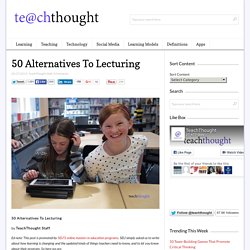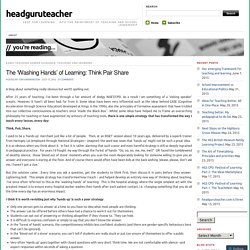

50 Alternatives To Lecturing. 50 Alternatives To Lecturing by TeachThought Staff Ed note: This post is promoted by SEU’S online masters in education programs.

SEU simply asked us to write about how learning is changing and the updated kinds of things teachers need to know, and to let you know about their program. So here we are. As teachers, when we lecture, we have the best of intentions. So explaining things isn’t “bad,” so how about beginning with some clarification. Everyone loves a story, and unless you’re awful, your students probably like you and want to hear from you. Or in a “flipped classroom” setting where the “lecture” is designed to be consumed at the student’s own pace (using viewing strategies, for example).
Or when students have mastered a core set of understandings, and are ready–in unison–to hear something from an honest-to-goodness expert who only has an hour to unload what he/she knows. …then lecture can be moderately effective, but even then it depends on what we mean by “effective.” Ideas for Teaching Better. All In One Place. So many ideas to share!

Most of the blogs I write that get a good response are the ones about teaching. Thankfully. I’d write a book but a) it takes too much time b) the money is terrible and c) I’d just be repeating everything I’ve already written here. It would be called ‘Into the Rainforest of Teaching and Learning’. I like the organic metaphor because it captures something of the mystery, complexity and beauty of teaching well.
Rainforest Thinking From Plantation Thinking to Rainforest Thinking: it’s quite a journey I like the idea that learning is ‘lush, diverse, unpredictable, evolving, daunting, exciting’. Great Lessons Although I’d change a few things, I’m still very happy with this series as a way to capture the essence of great lessons, especially the focus on habits rather than strategies. 1. You can download a pdf with all the posts compiled together in one easy-to-share document. Pedagogy Postcards 10 Silver Arrows If you do just one thing, do this….
Thanks for reading. Like this: The Education Endowment Foundation. What spinning class has taught me about motivation. Motivation is muddier than intrinsic versus extrinsic I am highly motivated to go spinning.

I tend to enjoy it during; I’m always really proud of myself after; and I’m very driven by my end goal of getting fitter. I’m showing up of my own free will, in my evenings when I could be doing any manner of other things. I could walk out at any time with no sanction. I could turn down the resistance to low and give myself an easy ride. With all that, you might think the behaviour of the instructor would make little difference to how hard I work. The fact is, no matter how much you want it, when it’s hard-going and you’re huffing and puffing, your genuine desire to succeed isn’t enough. Passion: The absolute number one factor that makes the difference between a great class and a mediocre one is the enthusiasm of the instructor.
The ‘Washing Hands’ of Learning: Think Pair Share. A blog about something really obvious but worth spelling out.

After 25 years of teaching, I’ve been through a fair amount of dodgy INSET/CPD. As a result I am something of a ‘visiting speaker’ sceptic. However, it hasn’t all been bad; far from it. Some ideas have been very influential such as the ideas behind CASE (Cognitive Acceleration through Science Education) developed at Kings in the 1990s; also the principles of formative assessment that have trickled into our collective consciousness as teachers since ‘Inside the Black Box’. Whilst some ideas have helped me to frame an overarching philosophy for teaching or have augmented my armoury of teaching tools, there is one simple strategy that has transformed the way I teach every lesson, every day: Think, Pair, Share.
I used to be a ‘hands up’ merchant just like a lot of people. But the solution came: Every time you ask a question, get the students to think first, then discuss it in pairs before they answer. An everyday hands-up moment.. The ‘Washing Hands’ of Learning: Think Pair Share.